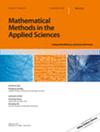On the analyzing of bifurcation properties of the one‐dimensional Mackey–Glass model by using a generalized approach
IF 2.1
3区 数学
Q1 MATHEMATICS, APPLIED
引用次数: 0
Abstract
The goal of this work is to look at how a nonlinear model describes hematopoiesis and its complexities utilizing commonly used techniques with historical and material links. Based on time delay, the Mackey–Glass model is explored in two instances. To offer a range, the relevance of the parameter impacting stability (bifurcation) is recorded. The power spectrum of the considered model is collected in order to analyze the periodic behavior of a solution in a differential equation. The complex nature of the system is relayed on a parameter which is illustrated in the bifurcation plot. Due to the fact that the considered model is associated with blood‐related diseases, the effect coefficients are effectively captured. The corresponding parameters‐based consequences of the generalized model in different order are deduced. The parametric charts for both examples reveal intriguing results. The current work enables investigations into complex real‐world problems as well as forecasts of essential techniques.用广义方法分析一维麦基-格拉斯模型的分岔特性
这项工作的目的是利用与历史和材料相关的常用技术,研究非线性模型如何描述造血及其复杂性。在时间延迟的基础上,对 Mackey-Glass 模型进行了两个实例的探讨。为了提供一个范围,记录了影响稳定性(分岔)的参数的相关性。为了分析微分方程解的周期性行为,收集了所考虑模型的功率谱。系统的复杂性反映在分岔图中的一个参数上。由于所考虑的模型与血液相关疾病有关,因此有效地捕捉到了效应系数。由此推导出了不同顺序的广义模型基于参数的相应后果。这两个例子的参数图都揭示了耐人寻味的结果。目前的工作有助于研究复杂的实际问题以及预测基本技术。
本文章由计算机程序翻译,如有差异,请以英文原文为准。
求助全文
约1分钟内获得全文
求助全文
来源期刊
CiteScore
4.90
自引率
6.90%
发文量
798
审稿时长
6 months
期刊介绍:
Mathematical Methods in the Applied Sciences publishes papers dealing with new mathematical methods for the consideration of linear and non-linear, direct and inverse problems for physical relevant processes over time- and space- varying media under certain initial, boundary, transition conditions etc. Papers dealing with biomathematical content, population dynamics and network problems are most welcome.
Mathematical Methods in the Applied Sciences is an interdisciplinary journal: therefore, all manuscripts must be written to be accessible to a broad scientific but mathematically advanced audience. All papers must contain carefully written introduction and conclusion sections, which should include a clear exposition of the underlying scientific problem, a summary of the mathematical results and the tools used in deriving the results. Furthermore, the scientific importance of the manuscript and its conclusions should be made clear. Papers dealing with numerical processes or which contain only the application of well established methods will not be accepted.
Because of the broad scope of the journal, authors should minimize the use of technical jargon from their subfield in order to increase the accessibility of their paper and appeal to a wider readership. If technical terms are necessary, authors should define them clearly so that the main ideas are understandable also to readers not working in the same subfield.

 求助内容:
求助内容: 应助结果提醒方式:
应助结果提醒方式:


